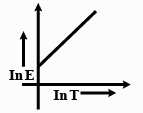Heat is flowing through a conductor of length \(l\) from \(x=0\) to \(x=L\). If its thermal resistance per unit length is uniform, which of the subsequent graphs is accurate?
1.

2.

3.

4.





Which of the following graphs correctly represents the relation between ln E and ln T where E is the amount of radiation emitted per unit time from unit area of a body and T is the absolute temperature?\(\left (Take~\sigma =5.67\times 10^{-8} ~W~m^{-2}~K^{-4}~and~0<\epsilon <1 \right )\)
(1)
(2)
(3)
(4) Both (1) and (3)
Which of the following is the v/s T graph for a perfectly black body ( =maximum frequency of radiation) ?
1. A
2. B
3. C
4. D
The plots of intensity versus wavelength for three black bodies at temperatures \(T_1,T_2\) and \(T_3\) respectively are as shown. Their temperatures are such that:

| 1. | \({T}_1>{T}_2>{T}_3 \) | 2. | \({T}_1>{T}_3>{T}_2 \) |
| 3. | \({T}_2>{T}_3>{T}_1 \) | 4. | \({T}_3>{T}_2>{T}_1\) |
The graph shown in the adjacent diagram, represents the variation of temperature (T) of two bodies, x and y having same surface area, with time (t) due to the emission of radiation. Find the correct relation between the emissivity (e) and absorptivity (a) of the two bodies .
1.
2.
3.
4.
The temperature of the two outer surfaces of a composite slab, consisting of two materials having coefficients of thermal conductivity K and 2K and thickness x and 4x, respectively are and ( > ). The rate of heat transfer through the slab, in a steady state is , with f which equals to:
1. 1
2.
3.
4.
A sphere and a cube of same material and same volume are heated upto same temperature and allowed to cool in the same surroundings. The ratio of the amounts of radiations emitted will be
1. 1 : 1
2.
3.
4.
A solid copper cube of edges 1 cm is suspended in an evacuated enclosure. Its temperature is found to fall from 100 to 99 in 100 s . Another solid copper cube of edges 2 cm, with similar surface nature, is suspended in a similar manner. The time required for this cube to cool from 100 to 99 will be approximately -
1. 25 s
2. 50 s
3. 200 s
4. 400 s
A solid sphere and a hollow sphere of the same material and size are heated to the same temperature and allowed to cool in the same surroundings. If the temperature difference between each sphere and its surroundings is same , then
1. The hollow sphere will cool at a faster rate for all values of T
2. The solid sphere will cool at a faster rate for all values of T
3. Both spheres will cool at the same rate for all values of T
4. Both spheres will cool at the same rate only for small values of T
The total energy radiated from a black body source is collected for one minute and is used to heat a quantity of water. The temperature of water is found to increase from 20 to 20.5 . If the absolute temperature of the black body is doubled and the experiment is repeated with the same quantity of water at 20, the temperature of water will be
1. 21 2. 22
3. 24 4. 28












